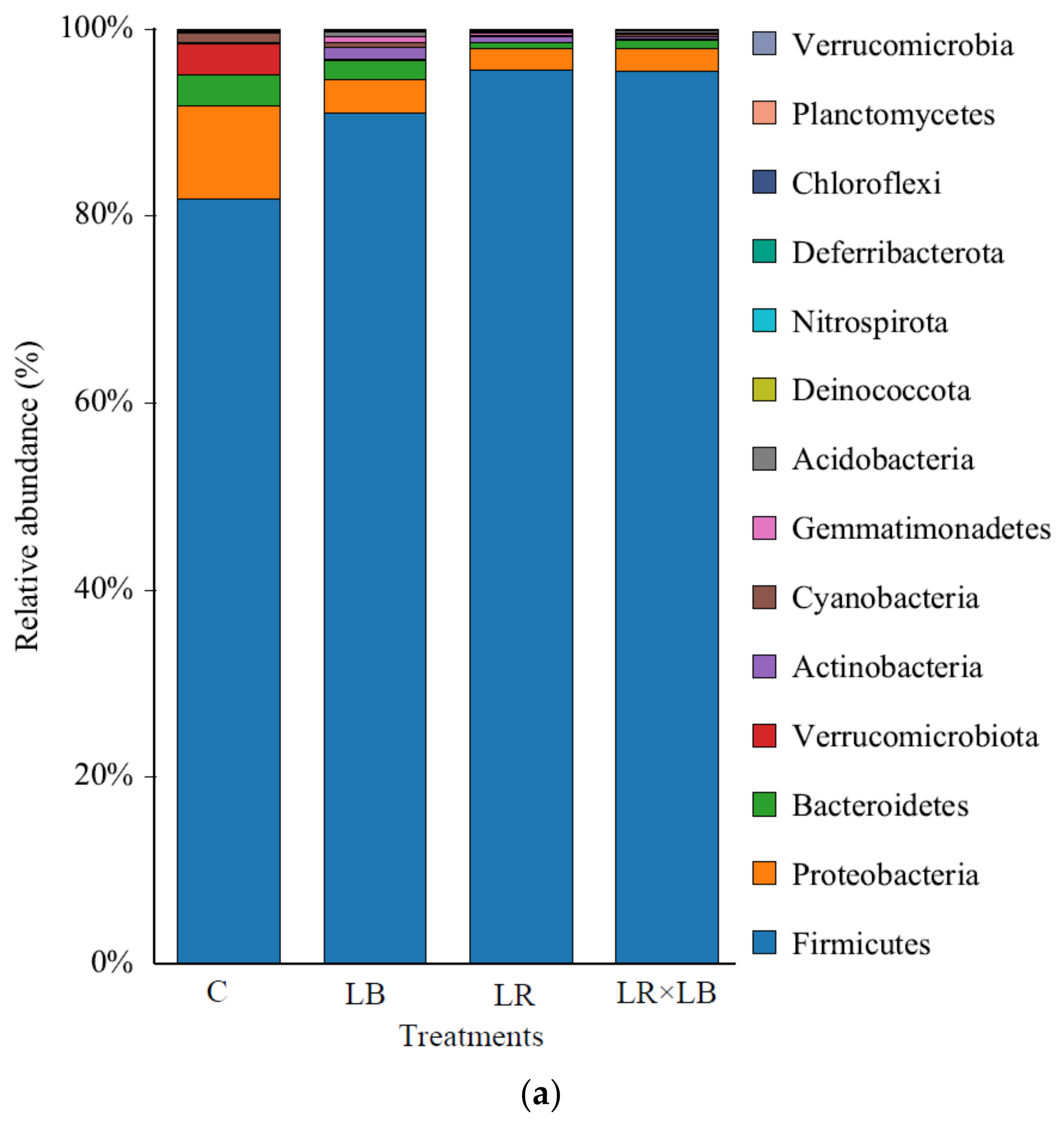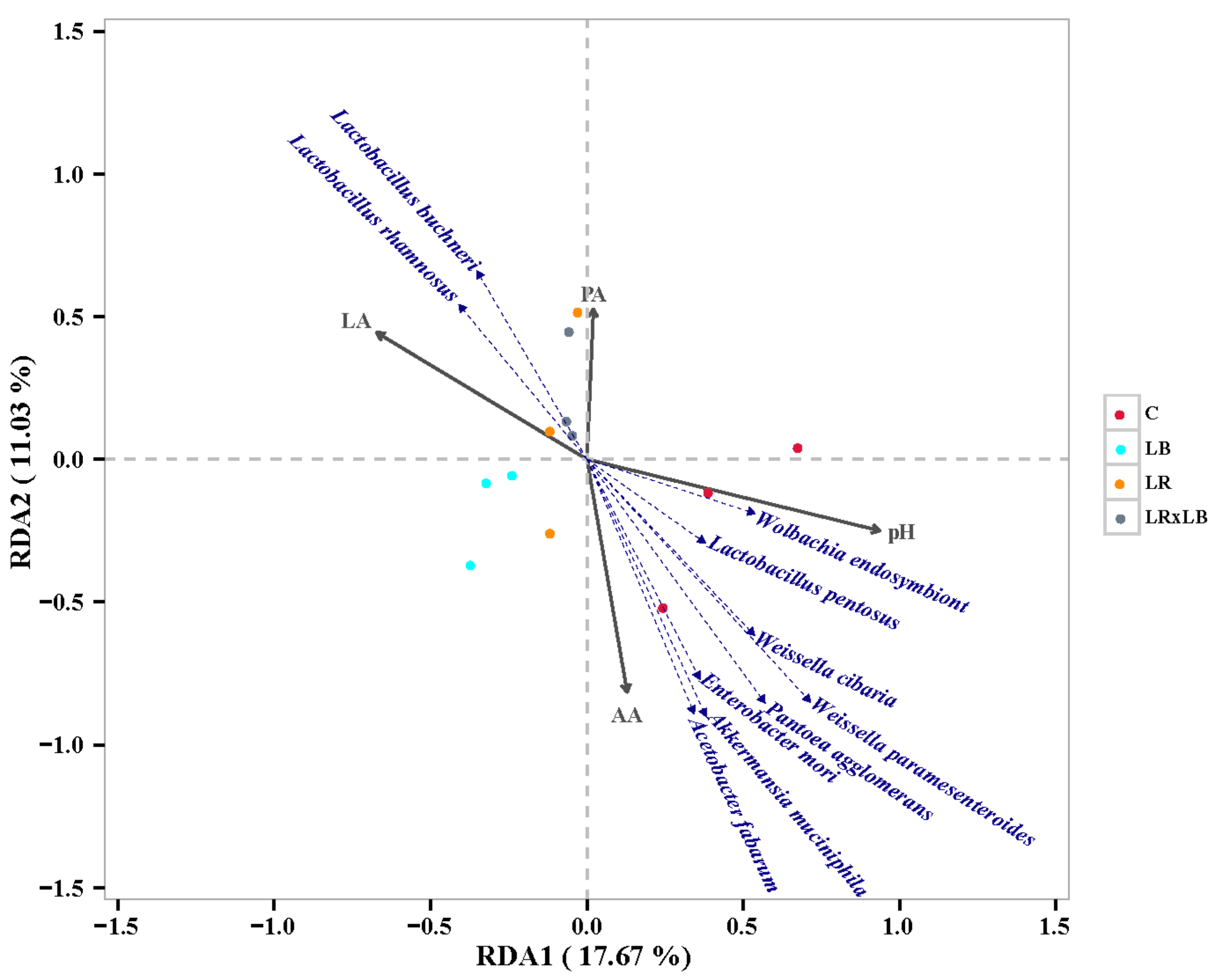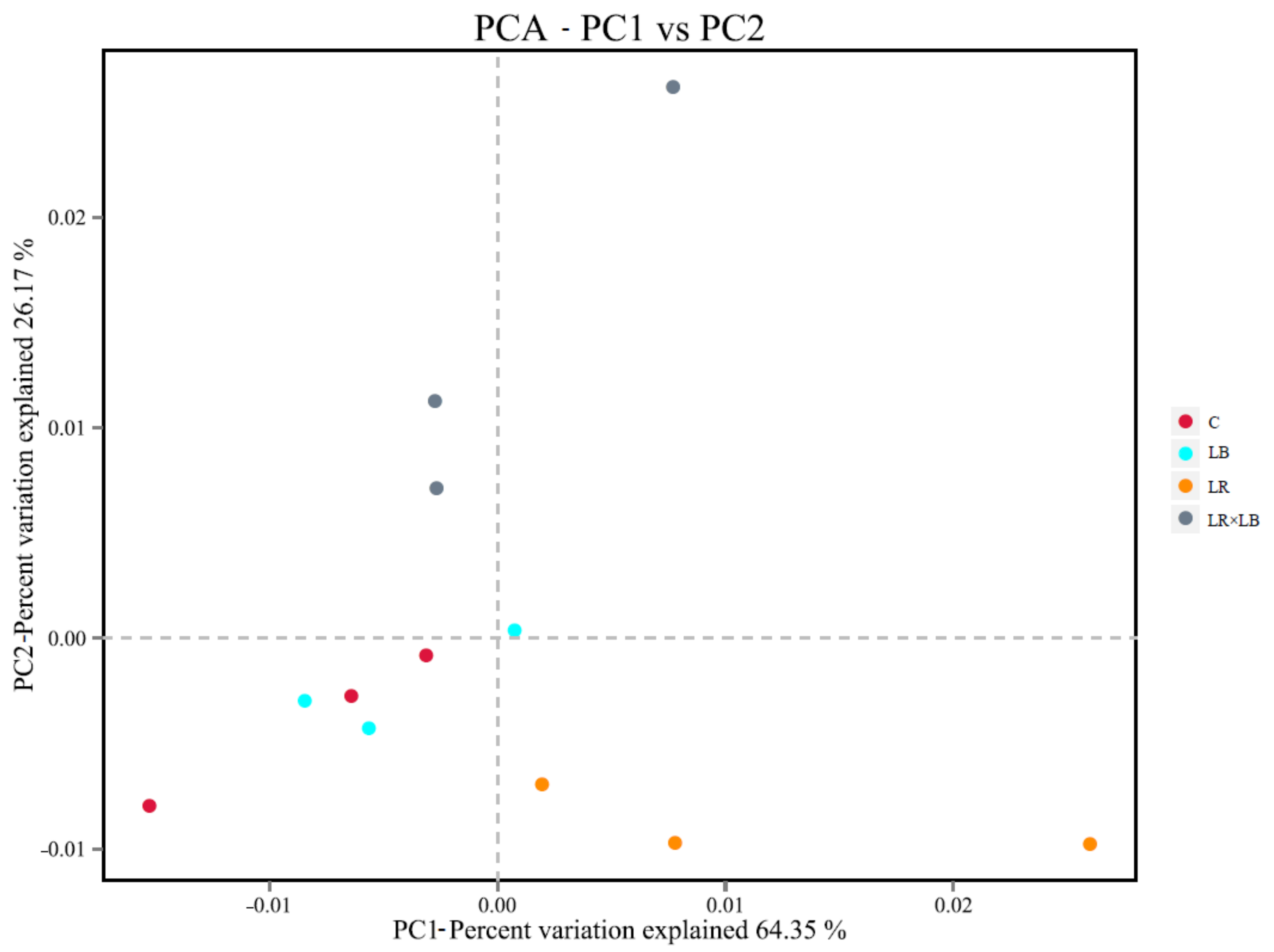Addition of Lactic Acid Bacteria Can Promote the Quality and Feeding Value of Broussonetia papyrifera (Paper Mulberry) Silage
Abstract
:1. Introduction
2. Materials and Methods
2.1. Preparation of Experimental Material
2.2. Characterization of Used Lactic Acid Bacteria Strains
2.3. Fermentation Characteristics
2.4. Chemical Composition and In Vitro Gas Production
2.5. Genetic Analysis
2.6. Statistical Analysis
3. Results
3.1. Fermentation Quality and Chemical Composition of Paper Mulberry Silage
3.2. In Vitro Gas Production of Paper Mulberry Silage
3.3. Microbial Community and Correlation Analysis of Paper Mulberry Silage
4. Discussion
4.1. Fermentation Quality, Chemical Composition and Correlation between Silage and Bacterial Community of Paper Mulberry Silage
4.2. In Vitro Gas Production of Paper Mulberry Silage
4.3. Microbial Community of Paper Mulberry Silage
5. Conclusions
Author Contributions
Funding
Informed Consent Statement
Data Availability Statement
Acknowledgments
Conflicts of Interest
References
- Peñailillo, J.; Olivares, G.; Moncada, X.; Payacán, C.; Chang, C.-S.; Chung, K.-F.; Matthews, P.J.; Seelenfreund, A.; Seelenfreund, D. Sex distribution of paper mulberry (Broussonetia papyrifera) in the pacific. PLoS ONE 2016, 11, e0161148. [Google Scholar] [CrossRef]
- Peng, X.; Wu, Q.; Teng, L.; Tang, F.; Pi, Z.; Shen, S. Transcriptional regulation of the paper mulberry under cold stress as revealed by a comprehensive analysis of transcription factors. BMC Plant Biol. 2015, 15, 108. [Google Scholar] [CrossRef] [PubMed] [Green Version]
- Tang, F.; Chen, N.; Zhao, M.; Wang, Y.; He, R.; Peng, X.; Shen, S. Identification and functional divergence analysis of WOX gene family in paper mulberry. Int. J. Mol. Sci. 2017, 18, 1782. [Google Scholar] [CrossRef] [Green Version]
- Kim, A.-J.; Park, S. Mulberry extract supplements ameliorate the inflammation-related hematological parameters in carrageenan-induced arthritic rats. J. Med. Food 2006, 9, 431–435. [Google Scholar] [CrossRef] [PubMed]
- Du, Z.; Lin, Y.; Sun, L.; Yang, F.; Cai, Y. Microbial community structure, co-occurrence network and fermentation characteristics of woody plant silage. J. Sci. Food Agric. 2021, 102, 1193–1204. [Google Scholar] [CrossRef] [PubMed]
- Venkataramanan, R.; Sreekumar, C.; Anilkumar, R.; Selvaraj, P.; Vidhya, N.M.; Mathagowder, I. Effect of jaggery on the quality and intake levels of maize silage. Trop. Anim. Health Prod. 2010, 42, 1027–1029. [Google Scholar] [CrossRef]
- Si, B.; Tao, H.; Zhang, X.; Guo, J.; Cui, K.; Tu, Y.; Diao, Q. Effect of Broussonetia papyrifera L. (paper mulberry) silage on dry matter intake, milk composition, antioxidant capacity and milk fatty acid profile in dairy cows. Asian-Australas J. Anim. Sci. 2018, 31, 1259–1266. [Google Scholar] [CrossRef] [PubMed] [Green Version]
- Hao, Y.; Huang, S.; Liu, G.; Zhang, J.; Liu, G.; Cao, Z.; Wang, Y.; Wang, W.; Li, S. Effects of different parts on the chemical composition, silage fermentation profile, in vitro and in situ digestibility of paper mulberry. Animals 2021, 11. [Google Scholar] [CrossRef]
- Yan, Y.; Li, X.; Guan, H.; Huang, L.; Ma, X.; Peng, Y.; Li, Z.; Nie, G.; Zhou, J.; Yang, W.; et al. Microbial community and fermentation characteristic of Italian ryegrass silage prepared with corn stover and lactic acid bacteria. Bioresour. Technol. 2019, 279, 166–173. [Google Scholar] [CrossRef]
- Cheng, Q.; Chen, Y.; Bai, S.; Chen, L.; You, M.; Zhang, K.; Li, P.; Chen, C. Study on the bacterial community structure and fermentation characteristics of fresh and ensiled paper mulberry. Anim. Sci. J. 2021, 92, e13656. [Google Scholar] [CrossRef]
- Guan, H.; Ke, W.; Yan, Y.; Shuai, Y.; Li, X.; Ran, Q.; Yang, Z.; Wang, X.; Cai, Y.; Zhang, X. Screening of natural lactic acid bacteria with potential effect on silage fermentation, aerobic stability and aflatoxin B1 in hot and humid area. J. Appl. Microbiol. 2020, 128, 1301–1311. [Google Scholar] [CrossRef]
- Peng, C.; Sun, W.; Dong, X.; Zhao, L.; Hao, J. Isolation, identification and utilization of lactic acid bacteria from silage in a warm and humid climate area. Sci. Rep. 2021, 11, 12586. [Google Scholar] [CrossRef]
- Dijkstra, J.; Kebreab, E.; Bannink, A.; France, J.; López, S. Application of gas production technique to feed evaluation systems for ruminants. Anim. Feed Sci. Technol. 2005, 1, 123–124. [Google Scholar] [CrossRef]
- Macome, F.M.; Pellikaan, W.F.; Hendriks, W.H.; Warner, D.; Schonewille, J.T.; Cone, J.W. In vitro gas and methane production in rumen fluid from dairy cows fed grass silages differing in plant maturity, compared to in vivo data. J. Anim. Physiol. Anim. Nutr. 2018, 102, 843–852. [Google Scholar] [CrossRef] [Green Version]
- Tian, J.; Li, Z.; Yu, Z.; Zhang, Q.; Li, X. Interactive effect of inoculant and dried jujube powder on the fermentation quality and nitrogen fraction of alfalfa silage. Anim. Sci. J. 2017, 88, 633–642. [Google Scholar] [CrossRef]
- Broderick, G.A.; Kang, J.H. Automated simultaneous determination of ammonia and total amino acids in ruminal fluid and in vitro media1. J. Dairy Sci. 1980, 63, 64–75. [Google Scholar] [CrossRef]
- Van Soest, P.J.; Robertson, J.B.; Lewis, B.A. Methods for dietary fiber, neutral detergent fiber, and nonstarch polysaccharides in relation to animal nutrition. J. Dairy Sci. 1991, 74, 3583–3597. [Google Scholar] [CrossRef]
- Turula, V.E.J.; Gore, T.; Singh, S.; Arumugham, R.G. Automation of the anthrone assay for carbohydrate concentration determinations. Anal. Chem. 2010, 82, 1786–1792. [Google Scholar] [CrossRef]
- Menke, K.H.; Raab, L.; Salewski, A.; Steingass, H.; Fritz, D.; Schneider, W. The estimation of the digestibility and metabolizable energy content of ruminant feedingstuffs from the gas production when they are incubated with rumen liquor in vitro. J. Agric. Sci. 1979, 93, 217–222. [Google Scholar] [CrossRef] [Green Version]
- Quast, C.; Pruesse, E.; Yilmaz, P.; Gerken, J.; Schweer, T.; Yarza, P.; Peplies, J.; Glöckner, F.O. The SILVA ribosomal RNA gene database project: Improved data processing and web-based tools. Nucleic Acids Res. 2013, 41, D590–D596. [Google Scholar] [CrossRef]
- He, L.; Li, S.; Wang, C.; Chen, X.; Zhang, Q. Effects of vanillic acid on dynamic fermentation parameter, nitrogen distribution, bacterial community, and enzymatic hydrolysis of stylo silage. Front. Microbiol. 2021, 12, 690801. [Google Scholar] [CrossRef]
- Xu, D.; Ding, Z.; Wang, M.; Bai, J.; Ke, W.; Zhang, Y.; Guo, X. Characterization of the microbial community, metabolome and biotransformation of phenolic compounds of sainfoin (Onobrychis viciifolia) silage ensiled with or without inoculation of Lactobacillus plantarum. Bioresour. Technol. 2020, 316, 123910. [Google Scholar] [CrossRef] [PubMed]
- Nair, J.; Huaxin, N.; Andrada, E.; Yang, H.-E.; Chevaux, E.; Drouin, P.; McAllister, T.A.; Wang, Y. Effects of inoculation of corn silage with Lactobacillus hilgardii and Lactobacillus buchneri on silage quality, aerobic stability, nutrient digestibility, and growth performance of growing beef cattle. J. Anim. Sci. 2020, 98, skaa267. [Google Scholar] [CrossRef] [PubMed]
- Li, M.; Zi, X.; Zhou, H.; Lv, R.; Tang, J.; Cai, Y. Silage fermentation and ruminal degradation of cassava foliage prepared with microbial additive. AMB Express 2019, 9, 180. [Google Scholar] [CrossRef]
- McDonald, P.; Henderson, A.R.; Heron, S.J.E. The Biochemistry of Silage; Chalcombe Publications: Southampton, UK, 1991; 340p. [Google Scholar]
- Kung, L.J.; Shaver, R.D.; Grant, R.J.; Schmidt, R.J. Silage review: Interpretation of chemical, microbial, and organoleptic components of silages. J. Dairy Sci. 2018, 101, 4020–4033. [Google Scholar] [CrossRef] [PubMed]
- Robinson, P.H.; Swanepoel, N.; Heguy, J.M.; Price, T.; Meyer, D.M. ‘Shrink’ losses in commercially sized corn silage piles: Quantifying total losses and where they occur. Sci. Total Environ. 2016, 542, 530–539. [Google Scholar] [CrossRef]
- Yang, F.; Wang, Y.; Zhao, S.; Wang, Y. Lactobacillus plantarum inoculants delay spoilage of high moisture alfalfa silages by regulating bacterial community composition. Front. Microbiol. 2020, 11, 1989. [Google Scholar] [CrossRef]
- da Silva, E.B.; Smith, M.L.; Savage, R.M.; Polukis, S.A.; Drouin, P.; Kung, L.J. Effects of Lactobacillus hilgardii 4785 and Lactobacillus buchneri 40788 on the bacterial community, fermentation and aerobic stability of high-moisture corn silage. J. Appl. Microbiol. 2021, 130, 1481–1493. [Google Scholar] [CrossRef]
- Joo, Y.H.; Kim, D.H.; Paradhipta, D.H.V.; Lee, H.J.; Amanullah, S.M.; Kim, S.B.; Chang, J.S.; Kim, S.C. Effect of microbial inoculants on fermentation quality and aerobic stability of sweet potato vine silage. Asian-Australas. J. Anim. Sci. 2018, 31, 1897–1902. [Google Scholar] [CrossRef]
- Kleinschmit, D.H.; Kung, L.J. The effects of Lactobacillus buchneri 40788 and Pediococcus pentosaceus R1094 on the fermentation of corn silage. J. Dairy Sci. 2006, 89, 3999–4004. [Google Scholar] [CrossRef] [Green Version]
- Der Bedrosian, M.C.; Nestor, K.E.J.; Kung, L.J. The effects of hybrid, maturity, and length of storage on the composition and nutritive value of corn silage. J. Dairy Sci. 2012, 95, 5115–5126. [Google Scholar] [CrossRef] [Green Version]
- Li, P.; Zhang, Y.; Gou, W.; Cheng, Q.; Bai, S.; Cai, Y. Silage fermentation and bacterial community of bur clover, annual ryegrass and their mixtures prepared with microbial inoculant and chemical additive. Anim. Feed Sci. Technol. 2019, 247, 285–293. [Google Scholar] [CrossRef]
- Bai, C.; Wang, C.; Sun, L.; Xu, H.; Jiang, Y.; Na, N.; Yin, G.; Liu, S.; Xue, Y. Dynamics of bacterial and fungal communities and metabolites during aerobic exposure in whole-plant corn silages with two different moisture levels. Front. Microbiol. 2021, 12, 663895. [Google Scholar] [CrossRef]
- Madsen, J.; Hvelplund, T.; Weisbjerg, M.R. Appropriate methods for the evaluation of tropical feeds for ruminants. Anim. Feed Sci. Technol. 1997, 69, 53–66. [Google Scholar] [CrossRef]
- Gallo, A.; Giuberti, G.; Atzori, A.S.; Masoero, F. Short communication: In vitro rumen gas production and starch degradation of starch-based feeds depend on mean particle size. J. Dairy Sci. 2018, 101, 6142–6149. [Google Scholar] [CrossRef] [Green Version]
- Johnson, K.A.; Johnson, D.E. Methane emissions from cattle. J. Anim. Sci. 1995, 73, 2483–2492. [Google Scholar] [CrossRef]
- Shah, A.A.; Qian, C.; Liu, Z.; Wu, J.; Sultana, N.; Mobashar, M.; Wanapat, M.; Zhong, X. Evaluation of biological and chemical additives on microbial community, fermentation characteristics, aerobic stability, and in vitro gas production of SuMu No. 2 elephant grass. J. Sci. Food Agric. 2021, 101, 5429–5436. [Google Scholar] [CrossRef] [PubMed]
- Zi, X.; Li, M.; Chen, Y.; Lv, R.; Zhou, H.; Tang, J. Effects of citric acid and lactobacillus plantarum on silage quality and bacterial diversity of king grass silage. Front. Microbiol. 2021, 12, 362. [Google Scholar] [CrossRef] [PubMed]
- McAllister, T.A.; Dunière, L.; Drouin, P.; Xu, S.; Wang, Y.; Munns, K.; Zaheer, R. Silage review: Using molecular approaches to define the microbial ecology of silage. J. Dairy Sci. 2018, 101, 4060–4074. [Google Scholar] [CrossRef] [Green Version]
- Ni, K.; Zhao, J.; Zhu, B.; Su, R.; Pan, Y.; Ma, J.; Zhou, G.; Tao, Y.; Liu, X.; Zhong, J. Assessing the fermentation quality and microbial community of the mixed silage of forage soybean with crop corn or sorghum. Bioresour. Technol. 2018, 265, 563–567. [Google Scholar] [CrossRef]
- Wang, Y.; He, L.; Xing, Y.; Zheng, Y.; Zhou, W.; Pian, R.; Yang, F.; Chen, X.; Zhang, Q. Dynamics of bacterial community and fermentation quality during ensiling of wilted and unwilted moringa oleifera leaf silage with or without lactic acid bacterial inoculants. mSphere 2019, 4, e00341-19. [Google Scholar] [CrossRef] [PubMed] [Green Version]
- Du, Z.; Risu, N.; Gentu, G.; Jia, Y.; Cai, Y. Dynamic changes and characterization of the protein and carbohydrate fractions of native grass grown in Inner Mongolia during ensiling and the aerobic stage. Asian-Australasian J. Anim. Sci. 2020, 33, 556–567. [Google Scholar] [CrossRef] [PubMed] [Green Version]
- Ali, N.; Wang, S.; Zhao, J.; Dong, Z.; Li, J.; Nazar, M.; Shao, T. Microbial diversity and fermentation profile of red clover silage inoculated with reconstituted indigenous and exogenous epiphytic microbiota. Bioresour. Technol. 2020, 314, 123606. [Google Scholar] [CrossRef] [PubMed]







| Items | Paper Mulberry |
|---|---|
| Dry Matter (g/kg of FM) | 384.78 |
| Crude Protein (g/kg of DM) | 164.71 |
| Neutral Detergent Fiber (g/kg of DM) | 490.13 |
| Acid Detergent Fiber (g/kg of DM) | 240.73 |
| Ash (g/kg of DM) | 80.23 |
| WSC (g/kg of DM) | 20.62 |
| C | LB | LR | LR × LB | SEM | p-Value | |
|---|---|---|---|---|---|---|
| Chemical composition | ||||||
| Dry matter (g/kg of FM) | 368.13 a | 375.70 a | 371.64 a | 372.30 a | 2.61 | 0.106 |
| Crude Protein (g/kg of DM) | 122.57 c | 147.63 a | 139.14 b | 146.35 ab | 3.13 | *** |
| Neutral Detergent Fiber (g/kg of DM) | 490.72 a | 502.24 a | 490.58 a | 499.31 a | 6.51 | 0.248 |
| Acid Detergent Fiber (g/kg of DM) | 241.68 a | 243.39 a | 237.08 a | 242.63 a | 5.6 | 0.686 |
| Ash (g/kg of DM) | 83.84 a | 85.84 a | 73.71 a | 78.33 a | 5.97 | 0.245 |
| DM loss (%) | 4.33 a | 2.36 a | 3.42 a | 3.24 a | 0.68 | 0.106 |
| Fermentation characteristics | ||||||
| pH | 4.65 a | 4.19 b | 4.20 b | 4.20 b | 0.05 | *** |
| Lactic acid (g/kg of DM) | 19.19 d | 42.27 c | 63.32 a | 52.16 b | 2.32 | *** |
| Acetic acid (g/kg of DM) | 10.47 a | 9.09 a | 9.82 a | 8.99 a | 1.51 | 0.746 |
| Propionic acid (g/kg of DM) | 7.97 c | 2.76 d | 12.28 b | 26.17 a | 1.58 | *** |
| Butyric acid (g/kg of DM) | ND | ND | ND | ND | ND | ND |
| Ammonia nitrogen (g/kg of FM) | 3.71 a | 3.10 b | 2.48 c | 3.04 bc | 0.26 | 0.007 |
| Lactic acid/acetic acid | 1.83 b | 4.68 a | 6.75 a | 5.93 a | 0.89 | 0.003 |
| Treatments | C | LB | LR | LR × LB | SEM | p-Value |
|---|---|---|---|---|---|---|
| Gas production per 1 g (mL) | ||||||
| GP2 | 58.07 a | 59.46 a | 58.25 a | 56.84 a | 1.56 | 0.468 |
| GP4 | 93.69 a | 95.25 a | 94.36 a | 91.25 b | 0.97 | 0.017 |
| GP6 | 130.08 b | 134.69 a | 131.22 ab | 127.48 b | 1.62 | 0.014 |
| GP8 | 161.46 b | 169.11 a | 167.23 a | 161.74 b | 2.23 | 0.017 |
| GP10 | 184.35 c | 193.99 ab | 194.93 a | 188.57 bc | 2.41 | 0.007 |
| GP12 | 205.58 c | 215.23 ab | 219.05 a | 210.40 bc | 2.75 | 0.006 |
| GP24 | 275.62 b | 282.42 ab | 290.81 a | 280.28 b | 3.86 | 0.025 |
| GP36 | 303.21 b | 308.05 b | 318.42 a | 307.11 b | 3.98 | 0.026 |
| GP48 | 317.16 b | 323.68 b | 333.89 a | 321.66 b | 4.00 | 0.017 |
| GP72 | 329.59 b | 337.18 b | 347.54 a | 334.99 b | 3.95 | 0.011 |
| OTU | Ace | Chao1 | Simpson | Shannon | Coverage | |
|---|---|---|---|---|---|---|
| C | 128 | 163.37 | 157.58 | 0.62 | 2.09 | 0.9965 |
| LB | 109 | 131.84 | 133.89 | 0.54 | 2.16 | 0.9973 |
| LR | 85 | 106.50 | 108.86 | 0.62 | 2.06 | 0.9979 |
| LR × LB | 107 | 133.44 | 138.98 | 0.50 | 2.19 | 0.9972 |
Publisher’s Note: MDPI stays neutral with regard to jurisdictional claims in published maps and institutional affiliations. |
© 2022 by the authors. Licensee MDPI, Basel, Switzerland. This article is an open access article distributed under the terms and conditions of the Creative Commons Attribution (CC BY) license (https://creativecommons.org/licenses/by/4.0/).
Share and Cite
Sun, W.-T.; Huang, Y.; Wu, C.-R.; Peng, C.; Zheng, Y.-L.; Chen, C.; Hao, J. Addition of Lactic Acid Bacteria Can Promote the Quality and Feeding Value of Broussonetia papyrifera (Paper Mulberry) Silage. Fermentation 2022, 8, 25. https://doi.org/10.3390/fermentation8010025
Sun W-T, Huang Y, Wu C-R, Peng C, Zheng Y-L, Chen C, Hao J. Addition of Lactic Acid Bacteria Can Promote the Quality and Feeding Value of Broussonetia papyrifera (Paper Mulberry) Silage. Fermentation. 2022; 8(1):25. https://doi.org/10.3390/fermentation8010025
Chicago/Turabian StyleSun, Wen-Tao, Yuan Huang, Chang-Rong Wu, Chao Peng, Yu-Long Zheng, Chao Chen, and Jun Hao. 2022. "Addition of Lactic Acid Bacteria Can Promote the Quality and Feeding Value of Broussonetia papyrifera (Paper Mulberry) Silage" Fermentation 8, no. 1: 25. https://doi.org/10.3390/fermentation8010025
APA StyleSun, W.-T., Huang, Y., Wu, C.-R., Peng, C., Zheng, Y.-L., Chen, C., & Hao, J. (2022). Addition of Lactic Acid Bacteria Can Promote the Quality and Feeding Value of Broussonetia papyrifera (Paper Mulberry) Silage. Fermentation, 8(1), 25. https://doi.org/10.3390/fermentation8010025






